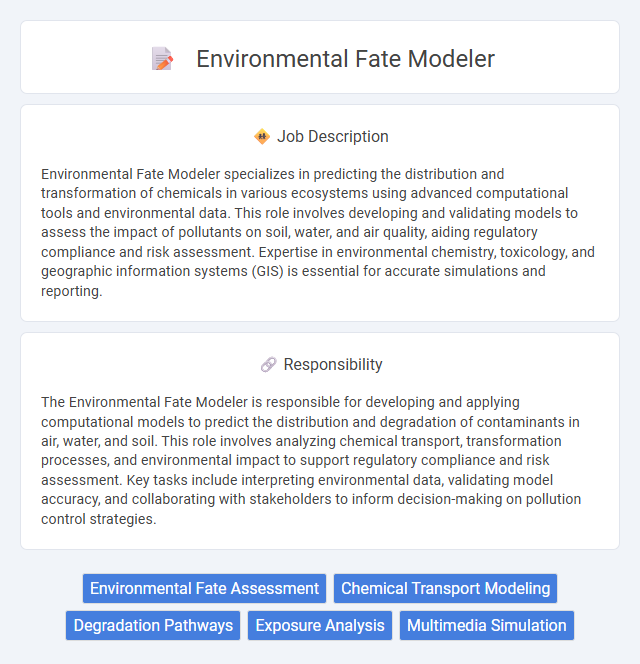
Environmental Fate Modeler specializes in predicting the distribution and transformation of chemicals in various ecosystems using advanced computational tools and environmental data. This role involves developing and validating models to assess the impact of pollutants on soil, water, and air quality, aiding regulatory compliance and risk assessment. Expertise in environmental chemistry, toxicology, and geographic information systems (GIS) is essential for accurate simulations and reporting.
Individuals with strong analytical skills and a background in environmental science or chemistry are likely to be well-suited for the Environmental Fate Modeler role. Those comfortable working with complex data and computer modeling may find this position engaging and rewarding. People who prefer hands-on fieldwork or less technical tasks might find this job challenging or less appealing.
Qualification
Expertise in environmental science and chemical fate modeling is essential for an Environmental Fate Modeler role. Proficiency with software tools such as ChemSim, AERMOD, or similar environmental fate modeling programs is highly valued. A strong background in data analysis, regulatory frameworks, and experience with risk assessments and environmental impact studies enhances qualification suitability.
Responsibility
The Environmental Fate Modeler is responsible for developing and applying computational models to predict the distribution and degradation of contaminants in air, water, and soil. This role involves analyzing chemical transport, transformation processes, and environmental impact to support regulatory compliance and risk assessment. Key tasks include interpreting environmental data, validating model accuracy, and collaborating with stakeholders to inform decision-making on pollution control strategies.
Benefit
The Environmental Fate Modeler likely enhances the accuracy of predicting chemical behavior in various ecosystems, improving risk assessment processes. This role may contribute to better decision-making in environmental protection and regulatory compliance. It probably supports sustainable development by identifying potential pollutant impacts before they occur.
Challenge
The Environmental Fate Modeler likely faces the challenge of accurately predicting the movement and transformation of chemicals in diverse ecosystems, which requires integrating complex data from multiple environmental compartments. There is a probable difficulty in managing uncertainties inherent in environmental parameters and chemical behaviors, necessitating the development of robust models that can accommodate variability. Maintaining up-to-date knowledge on emerging contaminants and regulatory requirements could also be a persistent challenge impacting model relevance and application.
Career Advancement
Environmental Fate Modeler positions offer significant career advancement opportunities through specialization in chemical transport and degradation analysis in ecosystems. Mastery in predictive modeling software and regulatory compliance expertise enhances prospects for senior roles in environmental consulting firms and government agencies. Continuous professional development in climate impact assessment and risk evaluation leads to leadership positions in sustainable resource management.
Key Terms
Environmental Fate Assessment
Environmental Fate Modeler utilizes advanced simulation tools to predict the behavior, degradation, and transport of chemicals in various ecosystems, supporting comprehensive Environmental Fate Assessments. This role validates models against empirical data to ensure accurate forecasting of pollutant distribution across air, water, and soil compartments. Expertise in regulatory frameworks like EPA's CHEMFATE and EU REACH guidelines is critical for developing risk management strategies and ensuring compliance with environmental standards.
Chemical Transport Modeling
Environmental Fate Modelers specializing in Chemical Transport Modeling analyze the movement and transformation of chemicals in various environmental media such as air, water, and soil. They use advanced simulation software and mathematical models to predict contaminant dispersion, degradation, bioaccumulation, and ecological impacts. Expertise in atmospheric chemistry, hydrology, and toxicology is essential for assessing pollutant behavior and informing regulatory decisions.
Degradation Pathways
Environmental Fate Modelers analyze degradation pathways to predict how chemicals break down in various ecosystems, including soil, water, and air. They utilize advanced computational models and empirical data to simulate biotic and abiotic transformation processes, such as photolysis, hydrolysis, and microbial metabolism. Understanding these pathways helps assess the persistence and environmental impact of contaminants, guiding regulatory decisions and environmental risk assessments.
Exposure Analysis
Environmental Fate Modeler specializing in exposure analysis evaluates the distribution and concentration of contaminants in air, water, and soil to predict human and ecological exposure risks. Expertise in using advanced modeling software like AERMOD, CalTOX, and SWAT supports accurate simulation of pollutant transport, transformation, and degradation processes. Proficiency in interpreting exposure scenarios enhances regulatory compliance, risk assessment, and environmental impact mitigation strategies.
Multimedia Simulation
Environmental Fate Modeler specializes in multimedia simulation to predict the distribution and transformation of chemicals in air, water, soil, and sediment compartments. Utilizing advanced computational tools and fate and transport algorithms, the role supports risk assessment and regulatory decision-making by accurately modeling contaminant behavior across environmental media. Expertise in integrating physicochemical properties, degradation rates, and environmental parameters is essential for generating reliable simulation outcomes.
 kuljobs.com
kuljobs.com